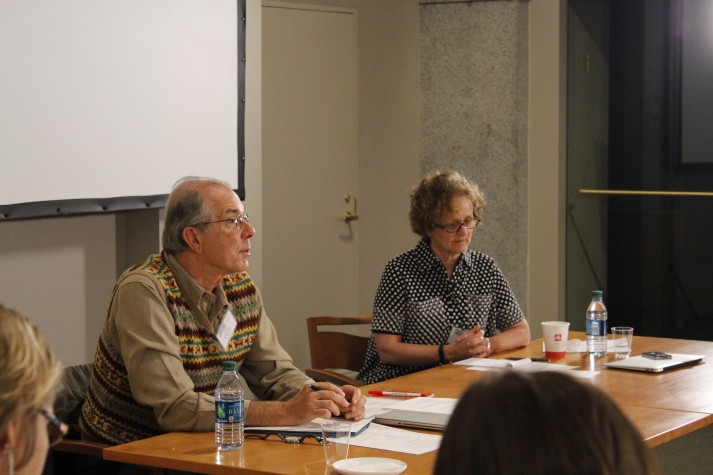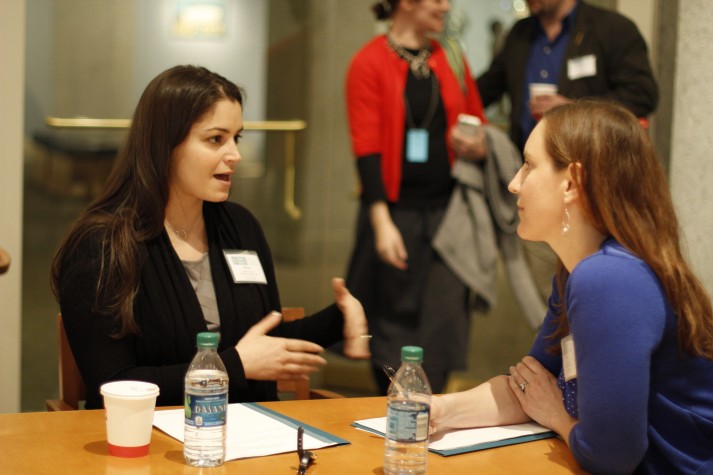Kristin Robinson graduated from the Conservation Center of the Institute of Fine Arts, NYU in 2012 and currently holds the position of painting conservator at Cranmer Art Group in NYC, where she specializes in the examination and treatment of modern and contemporary paintings.
At the end of March, Voices in Contemporary Art held a two day Artist Interview Workshop at the Lunder Conservation Center in Washington DC. The workshops, now in their third year, are well poised to further VoCA’s mission to facilitate the coming together of artists and art professionals toward a common goal of understanding and preserving contemporary art. By learning to effectively establish relationships with artists and record pertinent information for a larger audience, significant contributions to the field can be achieved. This task may seem daunting, however, especially for arts professionals working outside of large, well-funded institutions. As a conservator working in a private conservation studio in NYC and having no experience conducting interviews, I applied to the workshop unsure of the applicability of these new skills and with numerous questions in mind.

Richard Candida Smith and Jill Sterrett moderating the first day’s discussions.
Photo by Mary Tait. Courtesy of the Smithsonian American Art Museum.
The workshop participants proved to be an inspiring group, ranging from interns to department heads and collections managers to magazine editors, coming from museums, artist foundations, and even the US Department of State. Richard Candida Smith and Jill Sterrett deftly moderated the discussions, while numerous speakers illustrated their experiences. As a Professor of History at UC Berkley, Candida Smith brings years of oral history experience to the program, in part by sharing many useful insights regarding interview techniques, including strategies to illicit rich, candid answers from interviewees. He emphasized the importance of preparation and pre-interview research as well as having a clearly stated purpose before engaging with an artist. Jill Sterrett lent a thoughtful and prudent voice to the conversation, her experience as Director of Collections and Conservation at SFMOMA providing her with knowledge of the interviewer’s objectives. But what really struck me was her sensitivity to the position of the interviewee. She emphasized the benefits of building and maintaining relationships with artists, and suggested that turning to the video camera may not be appropriate in every situation, and that less formal means of documentation may, at times, be more fruitful.

Workshop participants engaging in mock interviews to practice their newly learned skills.
Photo by Mary Tait. Courtesy of the Smithsonian American Art Museum.
A few of the challenges I anticipated in conducting artist interviews as a conservator in private practice included the circumstances surrounding the discussion—within institutions interviews are most conveniently timed around acquisition, installation, and loan, whereas in a private conservation studio damage often dictates these interactions, potentially leading the artist to feel stress, or to come across as guarded or defensive. Legal limitations also stand to complicate the publication of interviews, especially if neither the artist nor interviewer owns the artwork being discussed. Even when enlightening conversations with an artist take place, the conservator-client relationship often demands discretion and the owner may be hesitant to release sensitive information regarding condition, especially if a work is on or entering the market. Another hindrance to any art professional working outside of a well-funded institution involves limited resources and technical proficiency. Which camera or microphone to buy (and how to operate them) may be enough to stop any eager interviewer in her tracks, but finding an appropriate site to host and archive the interviews may prove the biggest challenge yet.
To my delight, a number of these concerns were addressed during the workshop. Overcoming an artist’s anxieties about the state of preservation of his or her work may be easier if, as Sterrett suggests, a trusting relationship with the artist has already been established. Gwynne Ryan, Sculpture Conservator at the Hirshhorn, shared her experience with artist Ann Hamilton, in which multiple studio visits and conversations culminated in a successful treatment strategy and interview. Hugh Shockey, Object Conservator at the Lunder Conservation Center, illustrated how preparation and research can sometimes lead to unexpected discoveries about an artist’s intentions and ideas about preservation (see VoCA’s Artist Interview Resource page).
Many of the legal considerations surrounding artist interviews were addressed by Lauryn Guttenplan, Associate General Counsel to the Smithsonian Institution, who stressed the importance of clearly spelling out rights of ownership and intentions of use in a written agreement to be signed by the artist (and the owner when necessary).
Anne Reeve, Curatorial Associate at Glenstone and Steven O’Banion, Smithsonian Conservation Fellow at the Hirshhorn Museum and Sculpture Garden, presented contrasting strategies for how successful artist interview programs could be established in institutions with varying resources. In Reeve’s case, when faced with limited personnel and equipment, she garnered a relationship with a professional production company, allowing her to focus on content while rapidly growing their interview archive, while the Hirshhorn, lacking specific funding, repurposed equipment, utilized the technical knowledge of existing staff, and tapped into the Smithsonian’s Digital Asset Management System (DAMS) for their hosting and archiving needs. An overview of the recording equipment repurposed and purchased by the Hirshhorn was provided by Nick Kaplan, Collections Assistant at the Hirshhorn, offering great advice to anyone looking to embarking on an interview program.
Although conservators in private practice face different challenges than their colleagues in institutions, we are also in a unique position to work with contemporary artists freely and frequently, and should strive to document and share such experiences. As the VoCA Artist Interview Workshop proved, with a little creativity, flexibility, and training, pursuing artist interviews may not be so far beyond any art professional’s grasp.

[…] tips, practical challenges and solutions, and equipment details shared by experienced interviewers. An excellent summary of highlights has already been written by fellow attendee Kristin Robinson, so suffice to say here that my notes from the experience are […]